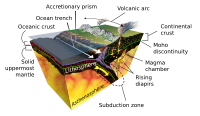
Photo from wikipedia
Abstract Slow-spreading mid-ocean ridges develop large offset normal faults, or detachments, that exhume mantle-derived peridotites to the seafloor. Successive detachments that flip polarity (flip-flop detachments) have been documented in corridors… Click to show full abstract
Abstract Slow-spreading mid-ocean ridges develop large offset normal faults, or detachments, that exhume mantle-derived peridotites to the seafloor. Successive detachments that flip polarity (flip-flop detachments) have been documented in corridors of nearly amagmatic spreading at the eastern Southwest Indian Ridge (SWIR). The depth of earthquake hypocenters supports the existence of a very thick axial lithosphere with a brittle lid thicker than 20 km. This is also consistent with our petrological observations on dredged peridotites from the area (plagioclase-free, spinel-bearing dynamically recrystallized assemblages in shear zones) that reveal high stress (80–270 MPa) and high temperature (>800 °C) deformation combining brittle and ductile mechanisms. Thermo-mechanical models using strain dependent cohesion weakening to localize deformation do not produce detachments for a brittle lithosphere thicker than 20 km. Here, we explore two other weakening mechanisms observed in situ, and for which we have temperature constraints from rock sampling: serpentinization (at T 350 °C) and grain size reduction by dynamic recrystallization (at T∼800–1000 °C). Serpentinization and more generally hydrous alteration minerals have been shown to localize strain at detachment-dominated slow-spreading ridge locations. Here we show that grain size reduction due to dynamic recrystallization also occurs in peridotites from the eastern SWIR. Our models explore the effect of implementing these weakening mechanisms separately or together in an amagmatic spreading context, of varying the threshold conditions for their activation, and the thermal conditions on-axis. We show that serpentinization alone does not produce flip-flop detachments, while grain size reduction alone does, albeit with unrealistically high associated topographic relief. Combining the two, we observe the activation of several modes of axial deformation: horst mode, spider mode, and long or short-lived flip-flop detachments. Flip-flop detachment faulting, once initiated, can be activated over long periods of time, with fault topography and offsets that are consistent with geological observations in the eastern SWIR nearly amagmatic study area. The transition between these modes appears to depend on the amount and location of serpentine that has been produced in previous stages of faulting.
Journal Title: Earth and Planetary Science Letters
Year Published: 2020
Link to full text (if available)
Share on Social Media: Sign Up to like & get
recommendations!